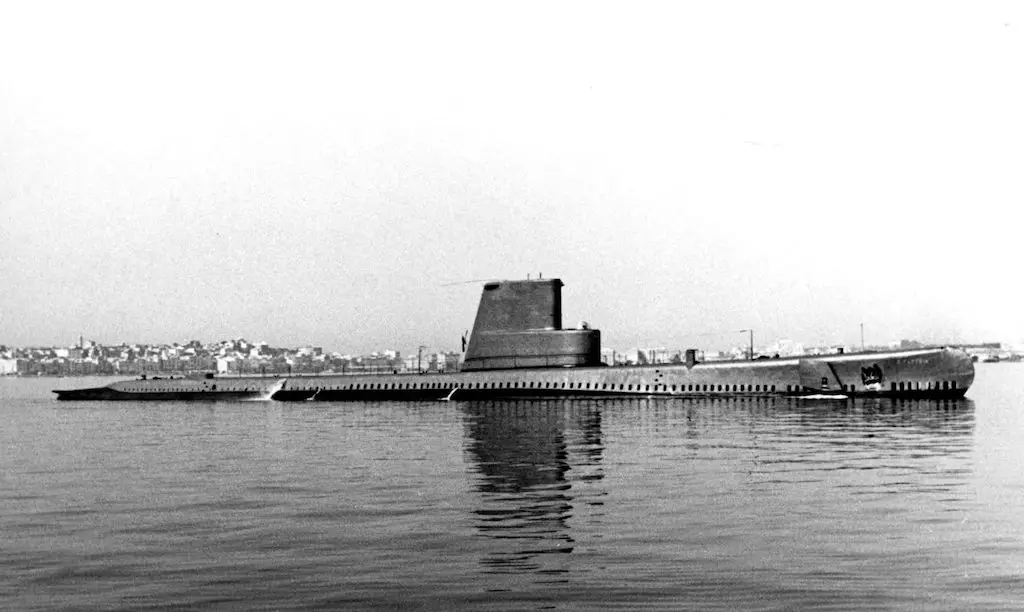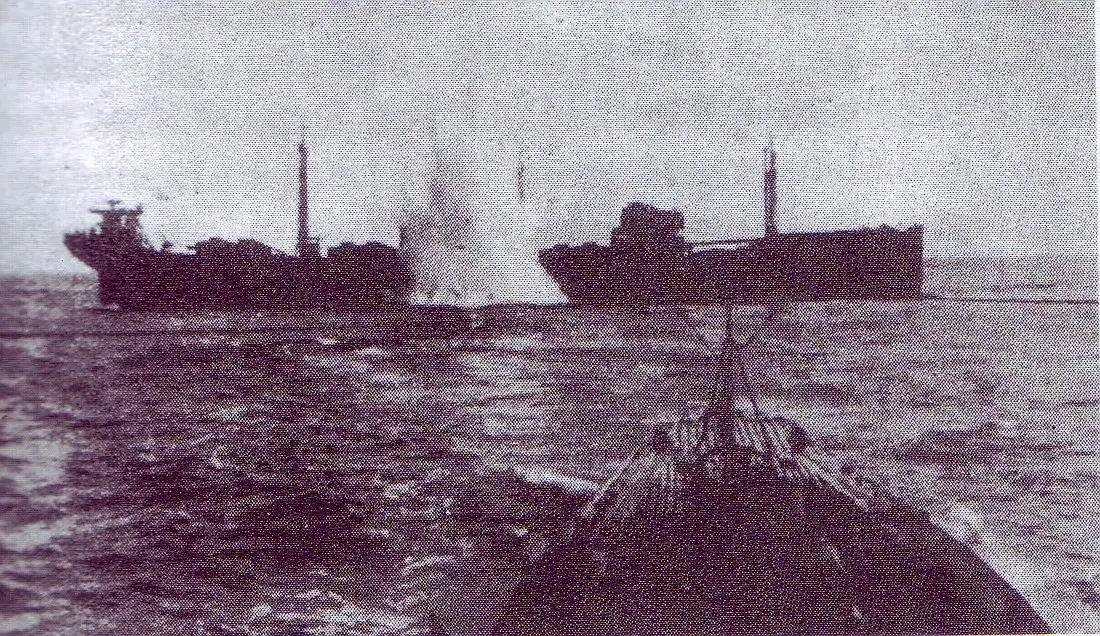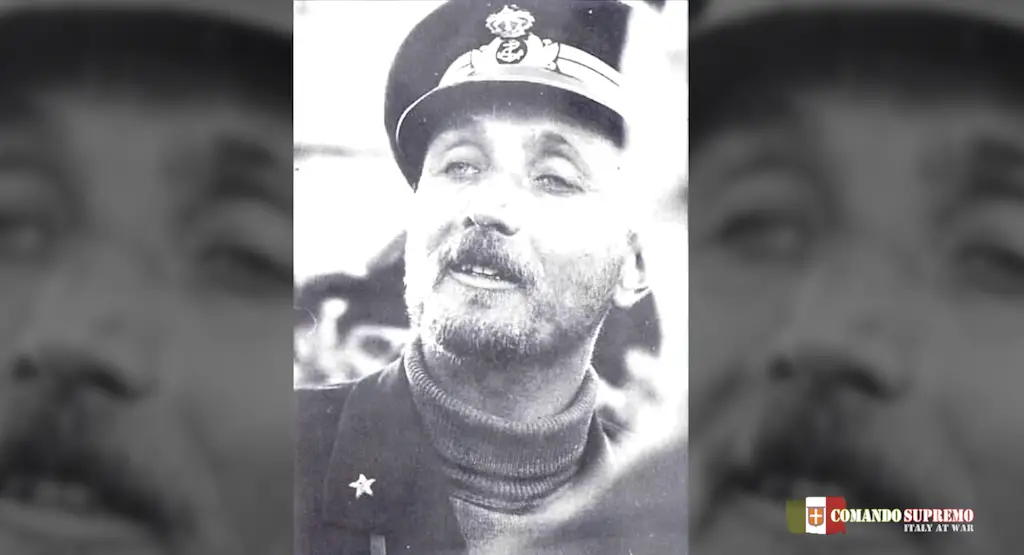Background on Carlo Fecia di Cossato
Carlo Fecia di Cossato was born in Rome on 25 September 1908 to a noble Biellese family of proven loyalty to the Savoia Dynasty. He studied in the Military College of Moncalieri, and in 1923 at the Livorno Military academy. In 1928, he became a Guardiamarina and a sub-lieutenant in 1929. After two years Cossato transferred to the naval bases in Beijing and then accepted for academic studies in Livorno.

Carlo Fecia di Cossato is credited for sinking 23 ships and an additional seven German vessels following the Armistice.
Submarine Force
During the Spanish Civil War, he took part on two special missions as a lieutenant. When Italy entered the war on 10 June 1940, Carlo Fecia di Cossato assumed command of the Bandiera class submarine “Menotti” of the 34° Squadriglia of Messina. With 52 crew members, the submarine completed several missions in the Mediterranean without any significant results.
Command of the Tazzoli
Designated as Lieutenant Commander in December 1940, he assumed command of the “Enrico Tazzoli”, a 1936 “ Calvi” class oceanic vessel, destined under his leadership to become legendary. The Tazzoli sank the Yugoslavian steamship Orao (5,100 tons on the 12 October 1941) and the English Ardanbahin (5900 tons. 27 December 1941). The future submarine Ace Gazzana Priaroggia, was his second in command for one year.

Italian submarine Enrico Tazzoli.
Patrols from Bordeaux
On 7 April 1941, he departed from Bordeaux in the direction of the West African coast. On 8 April 1941, Cossato attempted to intercept two anti-submarine ships. Fecia di Cossato attacked them before identifying the ships, eventually identifying them as two Spanish fishing boats. On 12 April 1941, the Tazzoli fired two torpedoes unsuccessfully at a ship believed to be the English cruiser class “Bonaventure” around Finisterre Cape.
The first sinking took place a few days later. On 15 April 1941 while close to the Azores, the armed steamship Aurella (4,700 tons) avoided the first torpedo and returned cannon fire. The artillery duel with the Tazzoli ended with the English ship sinking.
Tactics
Fecia Di Cossato often used this tactic:
- First to immobilize the enemy ship with torpedoes
- Then finishing it off with artillery firepower after surfacing.
West African Coast
The following three weeks were unfruitful while accompanied by submarines “Baracca” and “Dandolo” around the Lisbon coast and then the south of Madeira and Canary Islands. Cossato attempted to attack a destroyer and a large steamship close to Sierra Leone on 16 May 1941 but was unsuccessful. However, in the following days, the Tazzoli sank the Norwegian Fernland (4,310 tons), a ship which became isolated from the Allied column OG59. The Tazzoli sank the Fernland with four torpedoes; 2 while submerged and 2 while surfaced at close range.
On 8 May 1941, while close to the equator, he intercepted the armed petrol vessel Alfred Olsen (8,800t.). The Olsen proceeded with its lights off and zig-zagged to avoid the torpedoes. The pursuit took several hours and made difficult with fog and heavy rains. However, on 9 May 1941, the Tazzoli sank the Alfred Olsen with its cannons.
Attacked by a Bristol Beaufort
The Tazzoli was attacked and bombed on 23 May 1941 by a Bristol Beaufort of the 217° RAF squad close to the Gironda estuary while returning to Bordeaux. It returned machine-gun fire and damaged the aircraft.
Silver Medal of Military Valor
In their first mission, Fecia Di Cossato sank three ships for a total of 17,860 tons, which broke a record in that time for Italian submarines. For this feat, Cossato received a Medaglia d’argento al valor militare.
On 15 July 1941, he sailed from Le Verdon sur Mer after completing a refit. He was directed to the Liberian waters, an area that proved to be weak in results. The Tazzoli intercepted a column of three liners with the two military escort units. This time he faced an aggressive response as the escort units launched several depth charges for several hours.
Rescuing the Germans
On 19 August 1941, he torpedoed the Norwegian Cistern Sildra (7,300 tons). However, due to a damaged propulsion vent the submarine returned to Bordeaux. He received a new mission with a humanitarian objective. Cossato received orders to save the shipwrecked crew of the German auxiliary destroyer Atlantis which HMS Devonshire sank. Additionally, the crew of the German supply ship Python, which scuttled itself after an engagement with the HMS Dorsetshire. Besides the Tazzoli, the Regia Marine dispatched submarines “Torelli”, “Calvi” and “Finzi” to help the two U boots already in the area.

A photo of Carlo Fecia di Cossato after receiving the “Knight’s Cross” from German Admiral Karl Donitz on 01 April 1942.
The encounter took place in Cape Verde Island on 16 December 1941. They were able to save 254 people. Despite Allied attacks using antisubmarine aircraft and depth charges, the column reached Saint Nazaire between the 23 and 29 December 1941. Cossato earned a German Cross.
Off the Coast of Florida
In the meantime, the United States entered the war. The Tazzoli had a new operational patrol area in the eastern part of Florida. It departed on 11 February 1942 and on 5 March 1942, he unsuccessfully torpedoed the English petrol ship Ripana (8,000 tons). However, Cossato found success against the Dutch cargo steamship Astrea (1,400 tons), and again just south of Bermuda, during the night, against the Norwegian Tonsberfjord (3,100 tons).
Caribbean Sea
Following orders of BETASOM, the submarine moved to the Caribbean Sea, which was less protected and heavily used by merchant vessels. On 8 March 1942, the Tazzoli sank Uruguayan Montevideo (5,800 tons) after several hours of pursuit. Although neutral, the Uruguayan ship did not have any national symbols.
Having only nine torpedoes remaining, Cossato asked submarine Finzi, which suffered an engine malfunction, to transfer its torpedo load. However, the “Finzi” was committed with the nafta supplies to the “Morosini”. Therefore, the “Tazzoli” patrolled between the Bahamas and Bermuda, and on 11 March 1942 torpedoed the Panamanense Cignet (3,630 tons).
Gold Medal of Military Valor
On 13 March 1942, it torpedoed the English steamship Daytonian (6,400 tons). Traveling north, the “Tazzoli” immobilized the petrol ship Athletqueen (8,800 tons) on 15 March 1942. Surfacing to complete the attack, the “Tazzoli” faced strong artillery fire. The Tazzoli leveled to periscope depth and rammed the enemy ship. The Tazzoli sank it, but the submarine’s three meters of the bow bent 90° degrees for 3 meters making the torpedo launcher unusable. This forced a rapid return to Bordeaux, where Carlo Fecia di Cossato was awarded the Medaglia d’oro al valor militare in sinking six ships for a total of 29,200 tons, a new record in the Italian Royal navy.
After completing repairs, the Tazzoli returned to sea on 18 June 1942 returned to the Caribbean Sea. On the following day, he managed to escape an airstrike by a Wellington of the 172° RAF squad.

Sinking the Greek ship Castor on 1 August 1942.
The military situation in the Atlantic had now changed due to the anti-submarine countermeasures the allied forces organized. Cossato gained permission to move southeast. Close to Trinidad he sank the Greek steamship Kastor (or Castor) (5,500 tons) and on the following day the petrol ship Havsten (6,100 tons). On 5 September 1942, he returned to Bordeaux.
South American Coast
A new patrol started on 14 November 1942 with a course laid in for north of Brazil. On 11 December the Tazzolo sank the English Empire Hawk close to Dutch Guinea, and a few hours later sank the Dutch Ombilin (5,700 tons) near Georgetown. In this case, they captured the crew.

On 21 December 1942, the Tazzoli torpedoed the English Queen City and recovered the ship’s crew. On 25 December 1942, the Tazzoli sank the US cargo ship Dona Aurora (5,000 tons) despite having one diesel engine out of commission. Failing to receive a resupply of eight torpedoes from Cagni scheduled for 3 January 1943, the Tazzoli returned to Bordeaux on 1 February 1943. It destroyed a Wellington with its machine guns during the return trip.
Another Gold Medal of Military Valor
Fecia Cossata sank 20,500 tons on this mission and won another Medaglia d’oro al valor militare. Cossato was awarded the command of torpedo boat Aliseo and of the 3° Mediterranean Squadron. Cossato was promoted to Captain of Fregata and consecrated with the War Cross of Military Valor, as well as the German Knightship of the Iron Cross.
The Sinking of the Tazzoli
On 16 May 1943, Cossato’s famous submarine, the Enrico Tazzoli, sank while under a transport mission. Capitano di Corvetta Giuseppe Caito was the commanding officer. News of Tazzoli’s sinking hit Cossato hard.
Italian Armistice & Actions Against Germans
Following the armistice on 8 September 1943, he was in Bastia with the torpedo boat Ardito, the Mas 543, 18 auxiliary boats and two steamships. Part of the crew consisted of Germans. While the corvette Cormorano sailed outside the roadstead, the anti-submarine ships UJ2203 and UJ2219 and seven German motorboats arrived in port.
At midnight Fecia di Cossato left the port. The Germans attacked and damaged the Ardito and Mas and captured their crews and their commanders with heavy losses. The port commander, Admiral Catalano Gonzaga di Cirella asked and obtained help from the army which was able to defeat the Germans and constrain them to abandon Bastia between 8 and 9 September 1943.
Cossato, with the Torpedo Boat Aliseo and Cormorano, attacked and sank German ships that were escaping. This action awarded him another Medaglia di bronzo al valor militare.
Traveling to Portoferraio but rerouted to La Spezia by Supermarina, Cossato with the Duke Aimone D’Aosta on board transferred the Aliseo to Palermo and then to Malta, following the armistice clauses.
New Italian Government and Insubordination
Cossato was bitter of the role the Allies gave the Italian collaborative forces. Additionally, the new Ivanoe Bonomi government of June 1944 did not give an oath of loyalty to the king. Fecia di Cossato refused to obey orders of the new ministry. He told Admiral Nomis di Pollone, commander of the siluranti “There is no admiral at this time we have to obey.”
Carlo Fecia di Cossato was removed from his duties, and prevented from entering in the Official circle when he was at Naples. During this period, it appeared that Fecia Cossato requested an audience with Umberto di Savoia on several occasions. The request never made it to the King’s desk.
Death
On the 27 August 1944, he shot himself in the head with a pistol while at a friends house in Naples. His suicide note read:
In the last nine months I thought about the sad moral position in which I find myself after the disgraceful defeat of the Navy, to which I resign only because an order from the King that asked us to make a great sacrifice to our military honor to be able to stay the Monarchy stronghold in the moments of peace. You understand what is happening today in Italy, and understand how we were betrayed with no dignity, and ended up by having committed an ignoble gesture without achieving any results. From this situation, I feel great bitterness, distaste for what surrounds me, and what matters the most distaste for myself. […] In the last months I think about the sailors of the Tazzoli, who are honorably at the bottom of the sea, and I believe my post is with them.
He wrote to his mother. “It is not enough to have feelings, success, money, but something else that I do not have anymore.”
Umberto II transferred the remains from Poggioreale to Bologna and built a tomb close to Fecia di Cossato’s family at his own expense.
Credited for 23 sinkings totaling 86,500 tons, he was the ace of the aces and the second by tonnage of the Italian submarine force in the Second World War. The Italian Republic has honored him by naming one of its submarines after him.
Bibliography
F. Mattesini “BETASOM. La guerra negli oceani“ USMM Roma 1993
E. Bagnasco “Submarines of WWII” U.S. Naval Institute Annapolis 1980
D. Brown “Warship losses of WWII” London Arms and Armor 1990
Bagnasco-Rastelli “Sommergibili in Guerra” Albertelli Parma 1989
J. Rowehr “Axis submarine successes” Greenhill 1999
P. Hervieux “I Marconi in Guerra” Storia Militare n.70/1999 Albertelli Ed.
M. Brescia “Gianfranco Gazzana Priaroggia” in Storia Militare 2001 Albertelli ed.
A. Rastelli “Carlo Fecia di Cossato, l’uomo,il mito e il marinaio”Ed.Mursia
G. Pardini “La non scelta del Maresciallo De Bono”Nuova Storia Contemporanea n.3/2001 ed Le Lettere